The Evelyn Owen Sub-Machine Gun
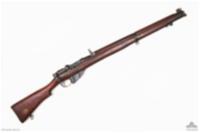
Lee-Enfield .303 Mk III*
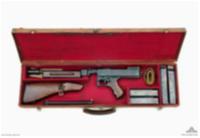
In WWII, Australian soldiers found themselves fighting a different kind of war against the Japanese in the Jungles of New Guinea. The main weapon of the Australian Infanteer was the .303 Mk III* with each section commander carrying a Thompson Sub-Machine Gun. While the .303 was the tried and tested workhorse of the Australian Army, it was very hard to bring to bear in close quarters combat. The Thompson Sub-Machine Gun was a very effective close quarters weapon but did not like the jungle environment and was prone to stoppages and required constant cleaning, on top of this it was expensive.
Evelyn Ernest Owen was born on the 15th of May 1915 in Wollongong NSW. Fascinated with all things mechanical Evelyn or ‘Evo' as he was known to his friends had a complete understanding of the combustion engine by the age of eight. Like most young boys he was interested in firearms, often he would be found tinkering with old broken shotguns and rifles turning out new parts to replace the broken ones. Once at the age of twelve he acquired an ancient hammerless shotgun. Turning a single piece of metal he made a new hammer and soon had the gun back to working order. Needless to say his curiosity would on occasion lead to injury. Many a time he find himself needing to be patched up by his mother. Along with firearms he also experimented with making homemade bombs, this too resulted in more scars.
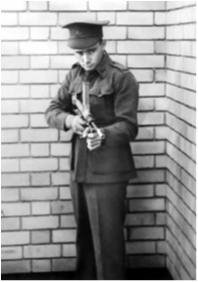
Evelyn Owen with his famous Owen Gun
As Evelyn grew older he concentrated more on the theory side of weapons and soon gained a tremendous knowledge of ballistics. While both his parents tried to divert his attentions to other things, Evelyn continued with his experiments. Moving on from single shot weapons he became interested in machine guns and soon he mastered draughtsmanship, now he could draw blueprints and finally experiment with his ideas on paper. In his late teens he designed and manufactured several machineguns but they never quite performed to the level Evelyn wanted. He was looking for a weapon that had a high rate of fire, was simple to make, did not jam and was accurate. In 1938, after many attempts and through sheer perseverance he finally produced his ultimate weapon The Owen Gun. With every inch of steel cut and turned Evelyn completely built his gun from the ground up. Firing accurately and without stoppages the simple construction of barrel, bolt, spring, pistol grip, one bent piece of bent steel for a stock and operated by the recoil of each shot, the Owen Gun was ready to be shown to the Australian Army.
One day in July Evelyn went into Sydney's Victoria Barracks, when asked by the officer "what have you in the bag son" Evelyn replied "It's a Tommy-Gun" The officer quickly snapping back "That is an American gangsters gun; the army has no use for those". Despite being shot down in flames by the officer Evelyn continued with his design.
In May 1940 Evelyn followed his brothers David, Julian and Peter into the AIF. He packed his invention into grease and put it into an old sugar bag and left it in a garage occupied by a tenant in a house owned by his father. Little did Evelyn know that tenant happened to be Vincent A. Wardell, the General-Manager of Lysaght's Port Kembla now called Blue Scope Steel.
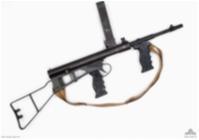
The Owen Sub-Machine Gun, Calibre 9mm, Length 813mm, Barrel Length 250mm, Weight Loaded 4.815kg, Rate of Fire 700 rpm, Muzzle Velocity 420mps
Sometime while Evelyn was off doing his training Mr Wardell found the bag containing the Owen Gun, taking the weapon out of the bag and firing the action Wardell knew a finely crafted piece of machinery when he saw one. With a simple operation and the bolt being the only working part Wardell knew he was on to something. After speaking with Evelyn's father, Mr Wardell sent a telegram to the Director General of Munitions a one Mr Essington Lewis. The telegram stated that he had found a marvellous firearm that was simple in construction and was worth taking a look at. Essington Lewis contacted the minister for Army, telling him that a young Wollongong man had invented a weapon that would be very useful to the war effort.
Things started to happen quite quickly, in 1941 Evelyn was told he was no longer need for army service and he must attend a meeting at the war office. Later in June of '41 he was discharged from the AIF and went to work in the Lysaght's factory. Lysaght's was given a contract to produce 100 Owen Guns and on the 30th of September 1941 Evelyn's Owen Gun went was tested at Long Bay Rifle Range against the best sub-machine guns of the day. Competing against a Thompson, Sten and even a German Bergmann the Owen Gun was found to be more accurate but the real test was to come. All the weapons were placed into water, sand and mud, the Owen Gun was the only one to keep firing while the others all stopped. The audience were left spellbound, now Evelyn Owen would finally get the recognition for his invention. Under Evelyn's watchful eye the Lysaght's factory went on to produce 45,477 guns for the Australian Army at a cost of 12 pounds ($24). Colonel Latchford along with some other army officers had been instrumental in procuring the contract for producing the weapons.
The Owen Gun was a purpose built jungle fighting arm, perfect for close quarters combat in the tropical environment. The weapon was also used in Korea, Malayan Emergency and Vietnam.
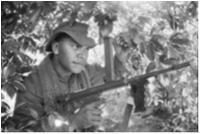
The Owen Gun in use in Vietnam, circa 1966
Owen did not worry about obtaining patents for his invention in 1942, it was not until after the war that he finally received 10 000 pounds in royalties. With these proceeds he bought a small sawmill at Tongarra, just outside of Wollongong. Unfortunately the mill returned little profit. Evelyn never married and became a heavy drinker. On the 1st of April 1949 he died at Wollongong hospital of a ruptured gastric ulcer. He was only 34.
In the Wollongong City Council Building located in Burelli St, Wollongong there is a bronze portrait made by his sister Eleanor Owen O'Donnell. This project was put together by family members and workers that produced the Owen Gun. The project was also supported by BHP Sheet and Coil Products, formally known as John Lysaght Ltd.
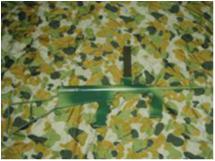
Two Colour paint scheme, Kokoda Historical Collection
The Evo Owen Story ISBN: 0-9751715-3-4 is available direct from the author Mr Clive Morton. Clive has written the only authorised version of the the Owen Gun story. If you would like to purchase a copy the price is $25. PO BOX 166 Gordonvale Qld 4865 or you can email Clive at hmorton@tpg.com.au
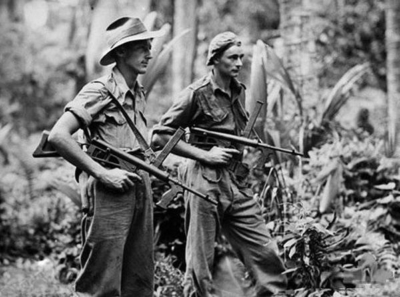
Owen Gun being used by Australian Commandos in WWII
